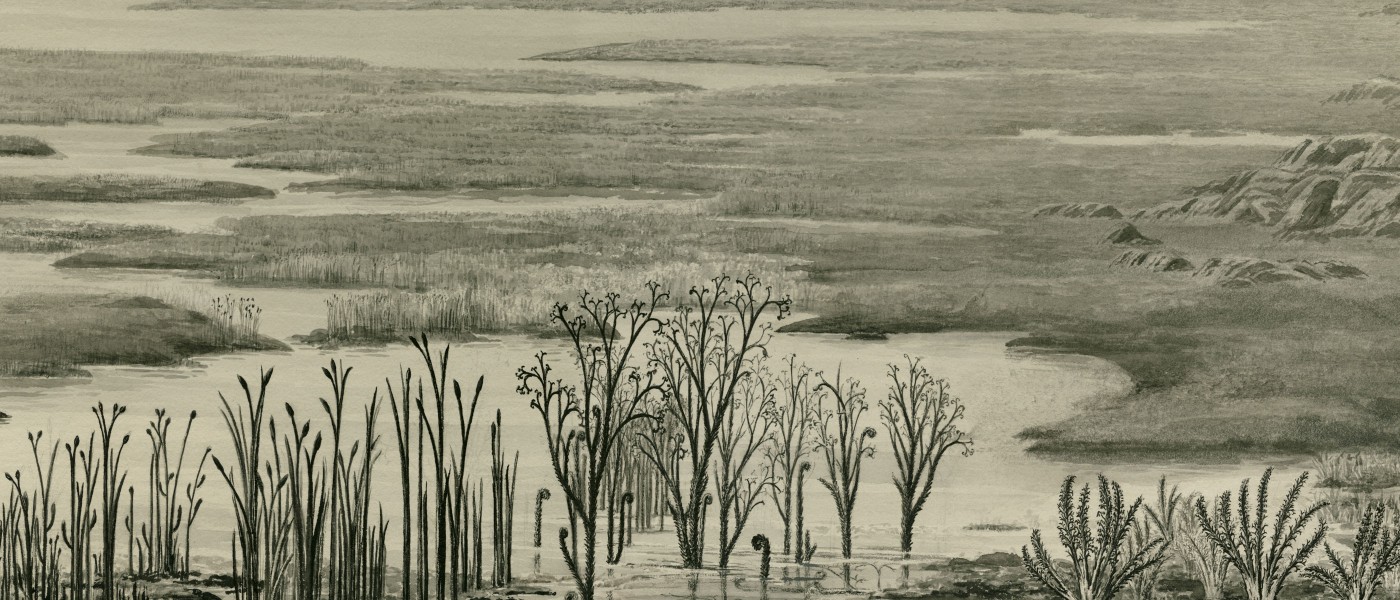Great Moments in Plant Evolution, Part 1: Plants Invade the Land
The history of life on Earth can be unbelievably daunting to comprehend, with so many millions of years before the advent of humans. This is the realm of the paleontologist, searching for clues to understand evolution, and hopefully to shed light on the present. As a multipart series, we will explore some of the major events during the evolution of plants. First we look at the humble origins of plants, and their incredible transition from water to land.
If we ventured back 500 million years ago (mya), we would likely see an Earth devoid of life on land. But despite the barren landscape, the oceans and lakes would have been teeming with a variety of algae and ancient animals, such as corals, invertebrates, and early fish.
It was during the Ordovician period (485–444 mya) that the first plants gained a foothold on land. In rocks dating from 470 mya, we find fossilized spores resembling those of living plants called liverworts. Research indicates that these early land plants evolved specifically from hairlike green algae that prospered on the edges of ponds. Over time, these algae acquired new features that allowed them to survive times of drought, eventually evolving into the land plants we find in the Ordovician fossil record.
The move to land also triggered the origin of the embryo—a zygote that was protected and nourished by the mother plant This is one of the defining characteristics of land plants and was likely an important advantage in the comparatively harsh terrestrial environment.
Liverworts, like mosses, are a type of bryophyte, a group of non-vascular plants that reproduce via spore. They are mostly small in stature and lack a sophisticated system for moving water through the plant. Many liverworts have a flattened kelp-like appearance, almost resembling lizard skin. The plants from the Ordovician period were likely similar in structure and had not yet evolved anything resembling leaves. They probably had an algal-like form, hugging the ground on the edges of wetlands.
In order to survive on dry land, these earliest plants would have had to solve several structural challenges by evolving. They would have had to develop adaptations to withstand the drying conditions and harsh ultraviolet light of the air, to deal with wind and gravity, and to obtain water and carbon dioxide. Modern liverworts (like most land plants) have a waxy layer called a cuticle that helps protect their tissue. Plants probably developed this adaptation in the Ordivician period. It would have been crucial for maintaining moisture during the transition from water to land.
In these ancestral land plants, we also observe rhizoids, hairlike structures for anchoring the plant to the ground, while absorbing water and minerals. These would not have been as sophisticated as modern roots, but sufficient for ancient plants since they were so small.
Even in the earliest ground-hugging bryophytes, we observe tiny upright shoots, tipped with spore sacs. Over time, plants would become progressively taller, driven by the success of releasing spores at greater heights to increase their range. From diminutive origins, plants became structurally taller and anatomically more complex throughout the Silurian period (444–419 mya).
As plants grew to be several inches tall, the task of transporting water became more challenging. Efficient piping structures called xylem then evolved and were able to move water from ground level to their growing tips. This feature is now found in 95 percent of all living plants, with wood being the most complicated version of xylem in the plant kingdom.
During the Silurian, we also see evidence of stomata, pores that open and close to allow gas exchange, but prevent desiccation. Stomata in modern plants are found mostly on leaves, but these early leafless plants also needed stomata in order to acquire carbon dioxide for photosynthesis while conserving precious water.
And lastly, one of the greatest accomplishments was the evolution of branching. The fundamental ability to fork and create new shoots was a monumental feat in plant evolution. An initial Y-shaped appearance in Silurian plants allowed them to cover more area and make more spores. Toward the end of the Silurian, branches would grow at different angles and dimensions; some stems grew bigger and upright for support, while others grew at an angle to capture sunlight and disperse spores.
The evolution of these fundamental structures sets the stage for an upcoming evolutionary explosion in diversity and form, as these foot-high plants spread throughout the landscape, eventually becoming tree-sized and creating the first forests.
More:
Great Moments in Plant Evolution, Part 2: The Origin of Trees and Forests
Great Moments in Plant Evolution, Part 3: Extinction to Ginkgo
Explore more in Brooklyn Botanic Garden's Trail of Plant Evolution which tells the story with live plants, fossil models and interpretive signs.


